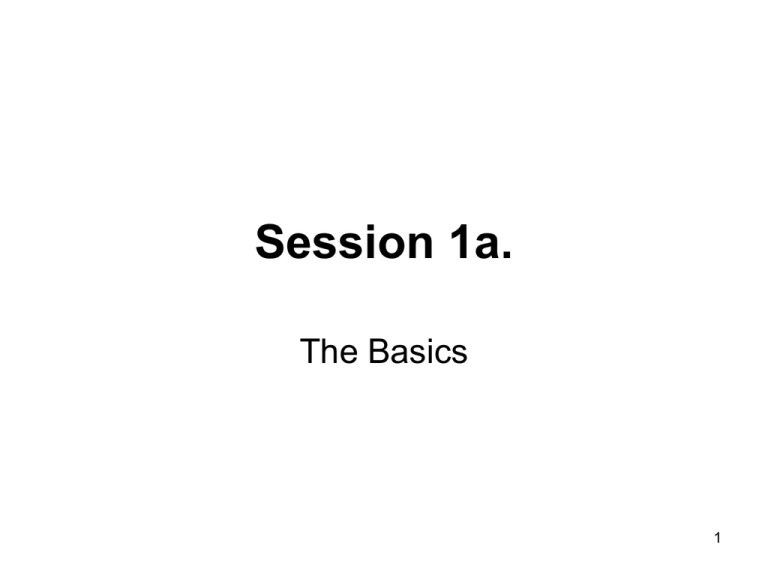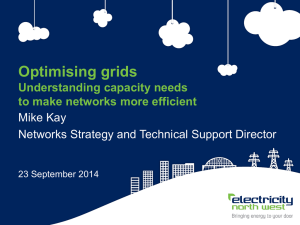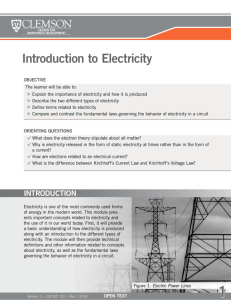Session 1A
advertisement

Session 1a. The Basics 1 What is Electricity? • Voltage – pressure – difference in charge • Current – flow of charge (a.k.a. electrons) Think of thunderclouds, lightning • Resistance / Reactance 2 What is Electricity? (cont.) • Metals – good conductors – electrons move around and among the atoms • Insulators – electrons move around but not among • Resistance – some electrons collide with the atoms 3 Two Hydrogen Atoms . . . Two hydrogen atoms were walking down the street. One says, “Oh my gosh – I’ve lost my electron.” The other asks, “Are you sure?” The first replies, “Yes … I’m positive.” 4 Revenge of the Sith 1 amp 6,300,000,000,000,000,000 electrons per second 5 Walt Whitman “I sing the body electric.” Leaves of Grass 6 Electricity is … • Electricity is the transmission of energy by waves or the movement of electrons (or electrical charge), either in a steady stream (direct current) or back and forth (alternating current). • Nobody really knows what the heck it is, so don’t worry about it. 7 “Electricity isn't a commodity; it's a phenomenon” (Joseph Swidler) • A way of transferring energy … without transferring “stuff” • Sort of like a bucket brigade … but without the bucket ! • Transferring energy by waves instead of stuff – bell buoy – clothesline & flowerpot • “It’s a puzzlement” (King of Siam) 8 WHAT IS IT ABOUT A TOASTER? • Reporter: “You mean when I plug in my toaster, the electrons don’t really go anywhere?!” • Check out old toasters at a flea market – no “on/off” switch! 9 Power & Energy • Power: The measure of instantaneous energy – energy divided by time • watts, kilowatts, megawatts • Energy: Work – power x time – equivalent to heat (That’s why you get hot when you’re workin’, Bubba) • watt-hrs., kilowatt-hrs., megawatt-hrs. 10 Electricity : Driving Energy is analogous to distance traveled – MWh or KWh or watt-hr. …… miles Power is analogous to speed or velocity – MW or KW or watts …… miles per hr. (mph) Energy = Power x time (MW-hr.) 11 Electricity : Driving (cont.) • Power = Energy divided by time • velocity = distance divided by time • P = E/t • MW = MW-hr. / hr. • v = d/t • mph = mi. / hr. • E = Pxt • MW-hr. = MW x hr. • d = vxt • mi. = mph x hr. 12 Kirchhoff’s Revenge There once was a fellow named Kirchhoff Whose laws many people steer clear of. You'd better obey them Or you'll have just mayhem, And Kirchhoff will come box your ears off! © George C. Loehr 1997 13 Kirchhoff’s Laws Kirchhoff’s Current Law • The algebraic sum of the currents into or out of a junction or node always equals zero ... or • “Amps in” equals “amps out” Kirchhoff’s Voltage Law • The algebraic sum of the voltage changes around a closed loop always equals zero ... or • The voltage change via any path equals the voltage change via any other path 14 The Giants • Gustav Kirchhoff (1824-1877) – Kirchhoff’s Laws, Robert Bunsen, “Frannhofer Lines” • Thomas Edison (1847-1931) – Invented light bulb, invented the electric power system • George Westinghouse (1846-1914) – AC system, transformer • Charles Proteus Steinmetz (1865-1923) – Rigorous mathematical foundation • Nikola Tesla (1856-1943) – 1-phase, 2-phase, 3-phase AC • Edith Clark (1883-1959) – Mathematical basis for analysis of very large AC power systems 15 Whatever Happened to Kirchhoff? Steinmetz and Tesla and Clark; Without them we’d be in the dark. Our volt, watt and var They put on a par With atom, electron and quark. © George C. Loehr 1997 16 WHY DID A.C. WIN ? AC makes changing voltage practical: • With DC, you have to use the same voltage for transmission as you use in your house • With AC, you can use transformers to change the voltage • Thus, you can use higher (even much higher) voltages for power transmission 17 WHY IS THIS IMPORTANT ? • It has to do with transmission losses • Power = Voltage x Current – P = E x I • If voltage is 10 times higher, current will be one-tenth as much (for the same power) • But MW losses are equal to current squared times resistance; voltage 10 times higher, current one-tenth – losses one/one hundredth • Increase voltage by factor of 100 … losses go down by one/ten thousandth!!!! 18 WHY … IMPORTANT ? • 100-fold increase in voltage (& 10,000-fold decrease in losses) is exactly the ratio achieved with 20 mi. line built from Niagara Falls to Buffalo in 1896 (11 kV, or 11,000 volts, vs. 110 volt “house current”) 19 Edison and Westinghouse Are Dead Thomas and George had a dither Whether DC or AC was better. Thomas was first, But was left in the lurch – High voltages favored the latter. © George C. Loehr 2002 20 GROWTH OF A.C. SYSTEMS • Standardization – AC, 3 phase, 60 cycles per sec. (Hertz) • Consolidation – mergers, acquisitions • Interconnection – only practical with AC – economy exchanges – load diversity – emergency assistance – reserve sharing 21 What Makes Power Flow (Loehr’s Second Law) • Power flows in an interconnection … – Via all paths – Inversely proportional to impedance • All lines will be affected by every power transaction or contingency The effect of a transaction over one portion of the interconnection on other portions is often called “Parallel Path Flow.” 22 23 24 25 Guy Consolmagno, SJ (Contemporary astronomer) “You never really understand Physics, you just get used to it.” 26











